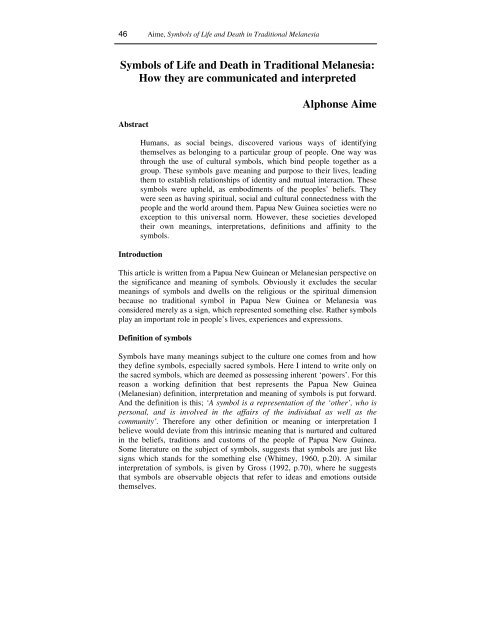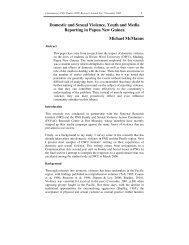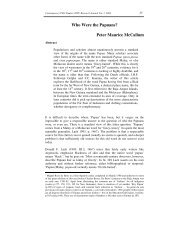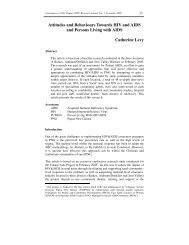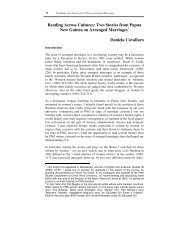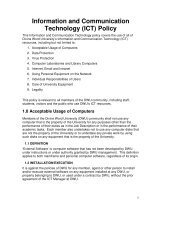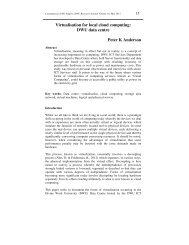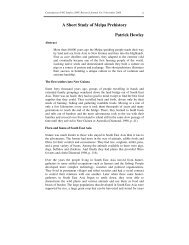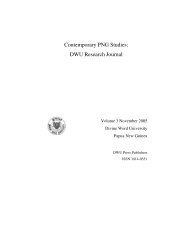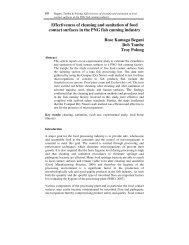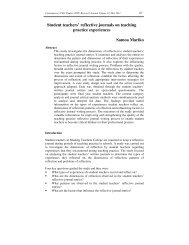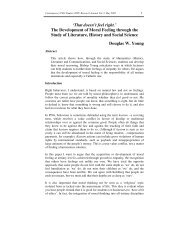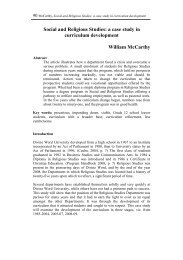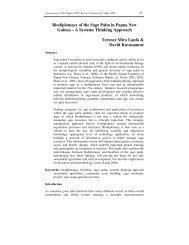Symbols of Life and Death in Traditional Melanesia - Divine Word ...
Symbols of Life and Death in Traditional Melanesia - Divine Word ...
Symbols of Life and Death in Traditional Melanesia - Divine Word ...
- No tags were found...
You also want an ePaper? Increase the reach of your titles
YUMPU automatically turns print PDFs into web optimized ePapers that Google loves.
46 Aime, <strong>Symbols</strong> <strong>of</strong> <strong>Life</strong> <strong>and</strong> <strong>Death</strong> <strong>in</strong> <strong>Traditional</strong> <strong>Melanesia</strong><strong>Symbols</strong> <strong>of</strong> <strong>Life</strong> <strong>and</strong> <strong>Death</strong> <strong>in</strong> <strong>Traditional</strong> <strong>Melanesia</strong>:How they are communicated <strong>and</strong> <strong>in</strong>terpretedAbstractAlphonse AimeHumans, as social be<strong>in</strong>gs, discovered various ways <strong>of</strong> identify<strong>in</strong>gthemselves as belong<strong>in</strong>g to a particular group <strong>of</strong> people. One way wasthrough the use <strong>of</strong> cultural symbols, which b<strong>in</strong>d people together as agroup. These symbols gave mean<strong>in</strong>g <strong>and</strong> purpose to their lives, lead<strong>in</strong>gthem to establish relationships <strong>of</strong> identity <strong>and</strong> mutual <strong>in</strong>teraction. Thesesymbols were upheld, as embodiments <strong>of</strong> the peoples’ beliefs. Theywere seen as hav<strong>in</strong>g spiritual, social <strong>and</strong> cultural connectedness with thepeople <strong>and</strong> the world around them. Papua New Gu<strong>in</strong>ea societies were noexception to this universal norm. However, these societies developedtheir own mean<strong>in</strong>gs, <strong>in</strong>terpretations, def<strong>in</strong>itions <strong>and</strong> aff<strong>in</strong>ity to thesymbols.IntroductionThis article is written from a Papua New Gu<strong>in</strong>ean or <strong>Melanesia</strong>n perspective onthe significance <strong>and</strong> mean<strong>in</strong>g <strong>of</strong> symbols. Obviously it excludes the secularmean<strong>in</strong>gs <strong>of</strong> symbols <strong>and</strong> dwells on the religious or the spiritual dimensionbecause no traditional symbol <strong>in</strong> Papua New Gu<strong>in</strong>ea or <strong>Melanesia</strong> wasconsidered merely as a sign, which represented someth<strong>in</strong>g else. Rather symbolsplay an important role <strong>in</strong> people’s lives, experiences <strong>and</strong> expressions.Def<strong>in</strong>ition <strong>of</strong> symbols<strong>Symbols</strong> have many mean<strong>in</strong>gs subject to the culture one comes from <strong>and</strong> howthey def<strong>in</strong>e symbols, especially sacred symbols. Here I <strong>in</strong>tend to write only onthe sacred symbols, which are deemed as possess<strong>in</strong>g <strong>in</strong>herent ‘powers’. For thisreason a work<strong>in</strong>g def<strong>in</strong>ition that best represents the Papua New Gu<strong>in</strong>ea(<strong>Melanesia</strong>n) def<strong>in</strong>ition, <strong>in</strong>terpretation <strong>and</strong> mean<strong>in</strong>g <strong>of</strong> symbols is put forward.And the def<strong>in</strong>ition is this; ‘A symbol is a representation <strong>of</strong> the ‘other’, who ispersonal, <strong>and</strong> is <strong>in</strong>volved <strong>in</strong> the affairs <strong>of</strong> the <strong>in</strong>dividual as well as thecommunity’. Therefore any other def<strong>in</strong>ition or mean<strong>in</strong>g or <strong>in</strong>terpretation Ibelieve would deviate from this <strong>in</strong>tr<strong>in</strong>sic mean<strong>in</strong>g that is nurtured <strong>and</strong> cultured<strong>in</strong> the beliefs, traditions <strong>and</strong> customs <strong>of</strong> the people <strong>of</strong> Papua New Gu<strong>in</strong>ea.Some literature on the subject <strong>of</strong> symbols, suggests that symbols are just likesigns which st<strong>and</strong>s for the someth<strong>in</strong>g else (Whitney, 1960, p.20). A similar<strong>in</strong>terpretation <strong>of</strong> symbols, is given by Gross (1992, p.70), where he suggeststhat symbols are observable objects that refer to ideas <strong>and</strong> emotions outsidethemselves.
Contemporary PNG Studies: DWU Research Journal Vol. 9 November 2008 47This underst<strong>and</strong><strong>in</strong>g does not subscribe to the mean<strong>in</strong>g <strong>of</strong> symbols from a PapuaNew Gu<strong>in</strong>ea perspective. It would be a western construct.My view is that the underst<strong>and</strong><strong>in</strong>g <strong>of</strong> the significance <strong>and</strong> value <strong>of</strong> culturalsymbols <strong>in</strong> Papua New Gu<strong>in</strong>ea has been constructed <strong>and</strong> understood from theEuropeans or expatriates, who have conducted studies <strong>in</strong>to this area. In mostwrit<strong>in</strong>gs, the western perceptions, <strong>in</strong>terpretations, def<strong>in</strong>itions <strong>and</strong> mean<strong>in</strong>gshave dom<strong>in</strong>ated the underst<strong>and</strong><strong>in</strong>g <strong>of</strong> the cultural symbols <strong>of</strong> Papua NewGu<strong>in</strong>eans. Westerners imposed their underst<strong>and</strong><strong>in</strong>g <strong>of</strong> <strong>Melanesia</strong>n symbols ascan be derived from this def<strong>in</strong>ition <strong>of</strong> symbols by Whitney (1960, p.20) whodef<strong>in</strong>es ‘symbols as anyth<strong>in</strong>g which st<strong>and</strong>s for someth<strong>in</strong>g else’, a def<strong>in</strong>ition thatbest fits the underst<strong>and</strong><strong>in</strong>g <strong>of</strong> signs which st<strong>and</strong> for someth<strong>in</strong>g else.In <strong>Melanesia</strong>n underst<strong>and</strong><strong>in</strong>g, symbols do not st<strong>and</strong> for someth<strong>in</strong>g else.<strong>Symbols</strong> st<strong>and</strong> for themselves as represent<strong>in</strong>g the ‘other’. For example, asacred mask symbol represents a liv<strong>in</strong>g ‘other’ which we may call a deity whohas a personality <strong>and</strong> <strong>in</strong>teracts with the community. If we take a nationalsymbol like a flag (a secular symbol), the same <strong>in</strong>terpretation applies. The flagis not a sign, which st<strong>and</strong>s for someth<strong>in</strong>g else, but rather the flag st<strong>and</strong>s foritself as the embodiment <strong>of</strong> values, identity <strong>and</strong> a people <strong>of</strong> a particularcountry.This paper is an <strong>in</strong>vitation to both expatriates <strong>and</strong> fellow Papua New Gu<strong>in</strong>eansto launch <strong>in</strong>to a deeper search for the mean<strong>in</strong>gs, def<strong>in</strong>itions, values,<strong>in</strong>terpretations <strong>and</strong> the significance <strong>of</strong> the cultural symbols as lived,experienced <strong>and</strong> expressed by the people. It is also <strong>in</strong>tended to open updiscussion <strong>in</strong> this rather complex area, which numerous authors have writtenabout.S<strong>in</strong>ce arriv<strong>in</strong>g on PNG shores, Westerners <strong>in</strong>clud<strong>in</strong>g missionaries, def<strong>in</strong>ed,<strong>in</strong>terpreted <strong>and</strong> gave mean<strong>in</strong>gs to the cultural symbols <strong>of</strong> PNG us<strong>in</strong>g their ownmean<strong>in</strong>gs <strong>and</strong> def<strong>in</strong>itions. This has resulted <strong>in</strong> conjectures <strong>and</strong> presentation <strong>of</strong>the beliefs <strong>of</strong> the people <strong>and</strong> their <strong>in</strong>herent beliefs <strong>of</strong> their cultural symbolsfrom a Western perspective. I believe that this article will contribute to a betterunderst<strong>and</strong><strong>in</strong>g <strong>of</strong> the cultural symbols from the Papua New Gu<strong>in</strong>ea perspective.In particular, the paper will discuss the three major characteristics <strong>and</strong>attributes <strong>of</strong> symbols associated with the beliefs <strong>of</strong> the people:• sacredness• power• efficacy.SacrednessIn <strong>Melanesia</strong> the sacredness <strong>of</strong> a symbol is demonstrated by the rituals to whichthe people must adhere. A symbol that is considered to be more sacred thanothers is accorded strict ritual observance. It is seldom displayed <strong>in</strong> public <strong>and</strong>very <strong>of</strong>ten revered. For example, the Tumbuan <strong>in</strong> Tolai society (a male society
Contemporary PNG Studies: DWU Research Journal Vol. 9 November 2008 49mean<strong>in</strong>g, however, the value <strong>and</strong> significance <strong>of</strong> the symbol may be quitedifferent. That is how complex the issue is. And if Westerners def<strong>in</strong>e, <strong>in</strong>terpret<strong>and</strong> give mean<strong>in</strong>g to the cultural symbols <strong>of</strong> PNG us<strong>in</strong>g their mean<strong>in</strong>gs <strong>and</strong>def<strong>in</strong>itions, they may not truly represent the beliefs <strong>of</strong> the Papua NewGu<strong>in</strong>eans, who live, experience <strong>and</strong> express these beliefs from day to day.The <strong>Melanesia</strong>n beliefs <strong>and</strong> underst<strong>and</strong><strong>in</strong>gs <strong>of</strong> symbolsIn <strong>Melanesia</strong>, especially Papua New Gu<strong>in</strong>ea, where the concept <strong>of</strong> spiritualitypermeates all activities <strong>in</strong> life, every symbol has mean<strong>in</strong>g <strong>and</strong> communicates aconstant flow <strong>of</strong> a relationship. Therefore every symbol is a representation <strong>of</strong>life <strong>and</strong> death. In the <strong>Melanesia</strong>n or PNG context, the underly<strong>in</strong>g belief is thatsymbols st<strong>and</strong> for the ‘other’. The ‘other’ exists <strong>and</strong> is represented by asymbol. This means that each symbol is considered to have a spiritual orreligious power.Some scholars have used the Polynesian or the <strong>Melanesia</strong>n term ‘mana’(power) to capture this concept (Moore, 1995, p.6). The WikipediaEncyclopedia explanation <strong>of</strong> <strong>Melanesia</strong>n mana suggests that mana is a sacredimpersonal force exist<strong>in</strong>g <strong>in</strong> the universe. Mana can be <strong>in</strong> people, animals,plants <strong>and</strong> objects. Similar to the idea <strong>of</strong> efficacy, or sometimes better knownas luck, the <strong>Melanesia</strong>ns thought all success was traced back to mana. Onecould acquire or manipulate this luck <strong>in</strong> different ways (for example throughmagic). Certa<strong>in</strong> objects that have mana can change a person’s luck. Howeverfor <strong>Melanesia</strong>ns, I believe the idea <strong>of</strong> mana is that it is sacred <strong>and</strong> personal, <strong>and</strong>real. It is not considered a matter <strong>of</strong> luck but a question <strong>of</strong> relationships. So theidea <strong>of</strong> mana be<strong>in</strong>g an impersonal force exist<strong>in</strong>g somewhere out there <strong>in</strong> theuniverse, to me, is a Western construct.The symbols possess <strong>in</strong>herent powers, which can be responsible for benevolentor malignant outcomes. Cultural symbols establish a liv<strong>in</strong>g network <strong>of</strong>relationships to the liv<strong>in</strong>g as well as to the dead <strong>and</strong> the spirit world. Thesymbols are revered as embodiments <strong>of</strong> peoples’ beliefs <strong>of</strong> the power that isdynamic <strong>and</strong> real, connect<strong>in</strong>g them to the ‘other’. Therefore for <strong>Melanesia</strong>ns(traditionally), symbols were not seen as mere identification marks <strong>of</strong> whichsociety or a group <strong>of</strong> people one belonged to, but more importantly, thesymbols evoked spiritual connectedness which was a liv<strong>in</strong>g reality. Forexample, Moore (1995, p.96) cites Tuz<strong>in</strong> (1980, p.324) who says, the‘Tambaran’ is more than the sum <strong>of</strong> ideas <strong>and</strong> artifacts.The mean<strong>in</strong>g <strong>of</strong> life <strong>and</strong> deathThe mean<strong>in</strong>g <strong>of</strong> life <strong>and</strong> death is broader than just physical life <strong>and</strong> death. It<strong>in</strong>cludes the existence <strong>and</strong> the prosperity <strong>of</strong> the community. Therefore thesignificance <strong>of</strong> the symbols is not only <strong>of</strong> personal <strong>in</strong>terest but is communitycentered as well. In traditional societies, it is through the community that onef<strong>in</strong>ds security <strong>and</strong> mean<strong>in</strong>g <strong>in</strong> life. So there was a complex network <strong>of</strong>relationships <strong>and</strong> the symbols were not to be seen <strong>in</strong> isolation from theirrelationship to the community. In any public display <strong>of</strong> sacred symbols the
50 Aime, <strong>Symbols</strong> <strong>of</strong> <strong>Life</strong> <strong>and</strong> <strong>Death</strong> <strong>in</strong> <strong>Traditional</strong> <strong>Melanesia</strong>community was seen as partak<strong>in</strong>g <strong>in</strong> the life-giv<strong>in</strong>g source <strong>of</strong> energy.Subsequently this energy had to be controlled <strong>and</strong> protected <strong>in</strong> order thatabundance <strong>of</strong> life or good times will flow <strong>in</strong>to the community. This wouldexpla<strong>in</strong> why before a public performance there is always ‘custom’ to beconsidered. Before the public display the process <strong>of</strong> negotiation <strong>and</strong>consolidation is put <strong>in</strong>to motion. The leaders or the organizers through their<strong>in</strong>termediaries get to work months before the event takes place. This process isfar more important than the actual display <strong>of</strong> colour <strong>and</strong> f<strong>in</strong>ery that one sees <strong>in</strong>the public arena. I shall now discuss this aspect <strong>of</strong> the importance <strong>of</strong> symbols tothe welfare <strong>and</strong> prosperity <strong>of</strong> the community.<strong>Symbols</strong> <strong>and</strong> community<strong>Symbols</strong> play major social, religious <strong>and</strong> economic functions <strong>in</strong> thecommunity. Correct relationship to symbols enables fullness <strong>of</strong> life for thecommunity. In practical terms it connotes good health, long life <strong>and</strong> abundance<strong>of</strong> cultural goods such as spouses, children, l<strong>and</strong>, crops, animals, game <strong>and</strong>fish, physical beauty, power, local wisdom <strong>and</strong> knowledge <strong>and</strong> prestige. In thisliv<strong>in</strong>g process <strong>of</strong> establish<strong>in</strong>g <strong>and</strong> susta<strong>in</strong><strong>in</strong>g relationships, the community<strong>in</strong>tends to avoid calamities which <strong>in</strong>clude death, sickness, barrenness <strong>of</strong>women, loss <strong>of</strong> power, loss <strong>of</strong> physical beauty, loss <strong>of</strong> ancestral l<strong>and</strong>, drought,fam<strong>in</strong>e, etc. Right relationship to symbols gives hope <strong>of</strong> cont<strong>in</strong>uous prosperity.The mean<strong>in</strong>gfulness <strong>of</strong> life is sourced through the network <strong>of</strong> relationships.Accord<strong>in</strong>g to Mantovani (1984, pp.195-210) community life is the only source<strong>of</strong> the fullness <strong>of</strong> life. For the societies <strong>in</strong> PNG, tradition has taught them thatthe fullness <strong>of</strong> life is atta<strong>in</strong>able only with<strong>in</strong> a community. It comprises humanbe<strong>in</strong>gs, ancestors, local spirits, animals <strong>and</strong> l<strong>and</strong>. Hence the greatest ethicalpr<strong>in</strong>ciple is whatever enhances community life is good; whatever endangerscommunity life is ethically bad or wrong. The whole traditional ethical systemis clan or community oriented. It is the community which has a nearly absolutevalue. The greatest punishment therefore is to be socially alienated orostracised from one's community. Therefore the work <strong>of</strong> establish<strong>in</strong>g rightrelationships is paramount, <strong>in</strong>clud<strong>in</strong>g relationship to the symbols. Relationshipsare created, ma<strong>in</strong>ta<strong>in</strong>ed <strong>and</strong> mended through exchanges which are seen to bereciprocal giv<strong>in</strong>g <strong>and</strong> receiv<strong>in</strong>g. By tradition, people have always exchanged <strong>in</strong>the form <strong>of</strong> gifts <strong>and</strong> valuable items as the medium, sometimes together withconsumer goods <strong>and</strong> artefacts, to susta<strong>in</strong> <strong>and</strong> reciprocate life.Media representation <strong>of</strong> symbolsS<strong>in</strong>ce the establishment <strong>of</strong> the Western media <strong>in</strong> the form <strong>of</strong> newspapers, radio,<strong>and</strong> television <strong>in</strong> PNG, the media has been writ<strong>in</strong>g, broadcast<strong>in</strong>g <strong>and</strong> televis<strong>in</strong>gtraditional performances <strong>of</strong> the people. The media’s representation, I believe,has been the one <strong>of</strong> deliver<strong>in</strong>g to the public the exotic elements <strong>of</strong> the culturalperformances <strong>and</strong> the different types <strong>of</strong> dances <strong>in</strong> PNG <strong>and</strong> their aestheticpatterns <strong>and</strong> array <strong>of</strong> colours. It is to be noted that these images <strong>of</strong> publicperformances are only outward expressions for the sake <strong>of</strong> enterta<strong>in</strong>ment. Thespectacle may neither please nor satisfy the onlooker. The deeper dimension is
Contemporary PNG Studies: DWU Research Journal Vol. 9 November 2008 51that we must pass beyond the sensuous form <strong>in</strong> order to penetrate its moreextended <strong>and</strong> more pr<strong>of</strong>ound mean<strong>in</strong>gHowever <strong>in</strong> its good <strong>in</strong>tention <strong>of</strong> promot<strong>in</strong>g the culture <strong>of</strong> the people, the mediahas at the same time disconnected the <strong>in</strong>tr<strong>in</strong>sic spiritual <strong>and</strong> social values thatgive mean<strong>in</strong>g to these cultural representations. This disconnectedness hascontributed to the view that cultural shows are mere performances, void <strong>of</strong> anycultural value <strong>and</strong> mean<strong>in</strong>gs. Cultural performances represent the beliefs <strong>and</strong>the values people have which b<strong>in</strong>d them together <strong>in</strong> their respective society orcommunity. Therefore cultural performances are symbols <strong>of</strong> the<strong>in</strong>terconnectedness people have with one another <strong>and</strong> the world around them.To discuss this po<strong>in</strong>t we will look at a case study where the media wasoblivious to the issue <strong>of</strong> the cultural significance <strong>of</strong> the dance but merelyreported on the differences <strong>of</strong> the parties <strong>in</strong>volved. This case study refers to thediscontentment which arose with the engagement <strong>of</strong> the Tumbuans <strong>of</strong> the Tolaipeople <strong>of</strong> East New Brita<strong>in</strong> to perform at the African, Caribbean <strong>and</strong> PacificMeet<strong>in</strong>g which was held <strong>in</strong> Port Moresby (PNG) <strong>in</strong> June 2006. The TolaiTumbuan Society opposed the idea <strong>of</strong> Tumbuans leav<strong>in</strong>g Rabaul <strong>and</strong> go<strong>in</strong>g toPort Moresby to enterta<strong>in</strong> the APC delegates. The custodians <strong>of</strong> the Tumbuansargued that it was culturally not proper for the Tumbuans to be taken out <strong>of</strong>their natural <strong>and</strong> cultural environment. They argued that if the delegates wantto see the Tumbuans, they had to come to the prov<strong>in</strong>ce. They raised concernthat a sacred dance such as the Tumbuan must not be taken out <strong>of</strong> the prov<strong>in</strong>ce.This amounts to disrespect <strong>of</strong> the sacred tradition <strong>and</strong> the mean<strong>in</strong>g <strong>of</strong> itscultural significance <strong>and</strong> value is dim<strong>in</strong>ished.The follow<strong>in</strong>g is how the media, PNG Post Courier, June 8, reported on thisissue <strong>of</strong> cultural significancePNG ‘MASK’ SOCIETY PROTESTS UNAUTHORIZEDDANCEPORT MORESBY, Papua New Gu<strong>in</strong>eaMore than 1000 tumbuans [masks] are understood to beprepar<strong>in</strong>g to march to the East New Brita<strong>in</strong> prov<strong>in</strong>cialheadquarters today to protest the movement <strong>of</strong> a sacred danceto Port Moresby last week. The K<strong>in</strong>avai dance was performed<strong>in</strong> Port Moresby last week dur<strong>in</strong>g the African, Carribean <strong>and</strong>Pacific (ACP) <strong>and</strong> European Commission Council <strong>of</strong>M<strong>in</strong>isters meet<strong>in</strong>gs. Attempts to get confirmation <strong>of</strong> theprotest from a senior member <strong>of</strong> the Tumbuan Society, MellyPaivu, were unsuccessful. However, another senior member <strong>of</strong>the society, John Rob<strong>in</strong>, who had previously stood up with MrPaivu to protest the br<strong>in</strong>g<strong>in</strong>g <strong>of</strong> the dance to Port Moresby,said there would be a demonstration today that will beattended by tumbuans from the Gazelle Pen<strong>in</strong>sula, Duke <strong>of</strong>York isl<strong>and</strong>s <strong>and</strong> New Irel<strong>and</strong>. It is understood the tumbuans
52 Aime, <strong>Symbols</strong> <strong>of</strong> <strong>Life</strong> <strong>and</strong> <strong>Death</strong> <strong>in</strong> <strong>Traditional</strong> <strong>Melanesia</strong>would gather at the prov<strong>in</strong>cial government headquarters atVunadidir <strong>and</strong> dem<strong>and</strong> a compensation <strong>of</strong> 250,000 tabu,(traditional shell money) which is the equivalent <strong>of</strong>PGK500,000 from the prov<strong>in</strong>cial adm<strong>in</strong>istration <strong>and</strong>organizers for not consult<strong>in</strong>g them before tak<strong>in</strong>g the dance out<strong>of</strong> the prov<strong>in</strong>ce, which is aga<strong>in</strong>st the Tumbuan Society’s laws.Mr Rob<strong>in</strong> <strong>and</strong> Mr Paivu were aga<strong>in</strong>st the movement <strong>of</strong> thetumbuans out <strong>of</strong> the prov<strong>in</strong>ce. Both men said a meet<strong>in</strong>g held <strong>in</strong>a men’s sacred place decided that the tumbuans would dem<strong>and</strong>compensation from the prov<strong>in</strong>cial government <strong>and</strong> organizerswho took the dance to Port Moresby. Failure to pay themwould see the tumbuans boycott<strong>in</strong>g the Mask Festival thisyear. ‘If these people know well that they have done wrong,they will immediately pay compensation to the othertumbuans,’ they said. Mr Paivu had said the prov<strong>in</strong>cialgovernment had not abided by its laws that the tumbuansrema<strong>in</strong> <strong>in</strong> a sacred place <strong>and</strong> not to be used to enterta<strong>in</strong> or betaken out <strong>of</strong> the prov<strong>in</strong>ce. Mr Rob<strong>in</strong> said accord<strong>in</strong>g to theTumbuan Society’s law, the tumbuans, who were due togather at Vunadidir today, would wait until they were givenwhat they wanted. Attempts to speak to the prov<strong>in</strong>cialadm<strong>in</strong>istration were unsuccessful. Meanwhile, a chamber <strong>of</strong>commerce meet<strong>in</strong>g planned for today has been postponed <strong>and</strong>members cautioned about possible effects on bus<strong>in</strong>ess <strong>of</strong> theplanned protest.Why did the Tolais take this st<strong>and</strong>?The follow<strong>in</strong>g comments try to expla<strong>in</strong> the st<strong>and</strong> taken by the Tolais by look<strong>in</strong>gat the <strong>in</strong>tr<strong>in</strong>sic value <strong>of</strong> symbols as understood by Papua New Gu<strong>in</strong>eans, whichmight assist the reader <strong>in</strong> appreciat<strong>in</strong>g the reasons for the resistance.Any symbol which has attributes <strong>of</strong> sacredness is treated with reverence <strong>and</strong>fear. For many Papua New Gu<strong>in</strong>eans, even the educated elite, are still attachedto traditional beliefs <strong>and</strong> live a life <strong>of</strong> double consciousness. They know theyare modern, yet they still carry with them the consciousness <strong>of</strong> the liv<strong>in</strong>gtradition. Accord<strong>in</strong>g to Thomson (1996, p.6) this is because:‘tradition survives, on this account, as a refuge for <strong>in</strong>dividualswho are unable or unwill<strong>in</strong>g to live <strong>in</strong> an age <strong>of</strong> radicaluncerta<strong>in</strong>ty. But it is difficult to believe that there is noth<strong>in</strong>gmore to it than that. To view the persistence <strong>and</strong> renewal <strong>of</strong>tradition as merely a defensive reaction to the process <strong>of</strong>modernization is to fail to see that there are certa<strong>in</strong> aspects <strong>of</strong>tradition which are not elim<strong>in</strong>ated by the development <strong>of</strong>modern societies, aspects which provide a foothold for thecont<strong>in</strong>ued cultivation <strong>of</strong> traditional beliefs <strong>and</strong> practices <strong>in</strong> themodern world’.
Contemporary PNG Studies: DWU Research Journal Vol. 9 November 2008 53The concept <strong>of</strong> symbols is one area that falls <strong>in</strong>to this category.Today <strong>in</strong> the media many aspects <strong>of</strong> culture are presented as enterta<strong>in</strong>ment <strong>and</strong>for promot<strong>in</strong>g tourism. Many <strong>of</strong> these presentations are seen from theperspective <strong>of</strong> a contemporary display <strong>of</strong> art forms. However, with regard tocerta<strong>in</strong> sacred symbols <strong>of</strong> cultural presentations, the rituals beh<strong>in</strong>d the sceneshave to be consolidated. This is to say that the custodians <strong>of</strong> the culturalpresentation have to perform certa<strong>in</strong> rites <strong>and</strong> rituals to celebrate the success <strong>of</strong>the event as well as to ward <strong>of</strong>f any unforeseen ill effects that may fall upon<strong>in</strong>dividuals or the community. It is a matter <strong>of</strong> life <strong>and</strong> death <strong>and</strong> the case <strong>of</strong> theTolai Tumbuan Society dramatically illustrates the po<strong>in</strong>t that sacred symbolsdeal with life <strong>and</strong> death.A case studyThe follow<strong>in</strong>g reports on an <strong>in</strong>terview conducted with a Tolai person whosefamily members are custodians <strong>of</strong> a tumbuan. The person made the follow<strong>in</strong>gremarks <strong>in</strong> relation to the saga concern<strong>in</strong>g the tumbuans go<strong>in</strong>g to Port Moresbyto show case PNG culture to the ACP-EU delegates. His comments as well asthe others, highlight the saga surround<strong>in</strong>g the <strong>in</strong>cident which sparked <strong>of</strong>f thisdebate.Accord<strong>in</strong>g to the <strong>in</strong>terviewee, tumbuans are sacred, so they must be accordedspecial reverence. Ample time must be given for the custodians to go throughthe process <strong>of</strong> engag<strong>in</strong>g the tumbuan, mean<strong>in</strong>g establish<strong>in</strong>g a dialogue. This isall done through a ritual process. After that the tumbuan leaves for theoccasion. All this time there is always a constant dialogue. After theperformance the tumbuan departs for home. Back home the process <strong>of</strong>welcome, appreciation <strong>and</strong> thank you is accorded to the tumbuan with rituals<strong>and</strong> ceremonies <strong>of</strong> cleans<strong>in</strong>g. For an outsider, a non participant or a spectator,this is not their concern. All these hidden ceremonies, rites <strong>and</strong> rituals <strong>of</strong>cleans<strong>in</strong>g are an expensive <strong>and</strong> time consum<strong>in</strong>g exercise. So the concern <strong>of</strong> theTolai tumbuan society was more related to these aspects rather than theperformance or the enterta<strong>in</strong>ment aspect <strong>of</strong> the tumbuan dance. The dem<strong>and</strong> forcompensation was not for the sake <strong>of</strong> compensation as such but rather fordialogue <strong>and</strong> establish<strong>in</strong>g relationships because it is <strong>in</strong> the nature <strong>of</strong> thetumbuan to be <strong>in</strong>teractive <strong>in</strong> relationship with the members <strong>of</strong> the community.Tumbuans are believed to be spirits <strong>of</strong> nature who are encountered by peopleespecially those who have been <strong>in</strong>itiated <strong>in</strong>to the tumbuan society. Thisencounter can take place <strong>in</strong> the bush or creeks or parts <strong>of</strong> the forest wherepeople believe these spirits live. This can happen when the person sleeps <strong>in</strong> theforest or at home <strong>and</strong> the spirit or spirits come to him <strong>in</strong> a dream. In the dreamthen, a particular dance is given to the person. The words <strong>of</strong> the dance, thestyle, rhythm <strong>and</strong> how to design <strong>and</strong> make the mask are all given by the spirit.The person learns all these from the dream. This is when the process <strong>of</strong>captur<strong>in</strong>g that particular spirit <strong>in</strong> a certa<strong>in</strong> form <strong>in</strong> the tumbuan mask beg<strong>in</strong>s.The person who now is the custodian <strong>of</strong> the tumbuan erects a sacred sanctuarywhere he beg<strong>in</strong>s to design the mask <strong>and</strong> at the same time teach others the
Contemporary PNG Studies: DWU Research Journal Vol. 9 November 2008 55performed without ‘custom’ <strong>and</strong> are part <strong>of</strong> the process <strong>of</strong> negotiation <strong>and</strong>consolidation through social networks. A lot that meets the eye goes <strong>in</strong>topreparation <strong>of</strong> song <strong>and</strong> dance. In essence what one sees is the outwardexpression only. Deeper values <strong>and</strong> obligations have to be constantlynegotiated by the owners <strong>of</strong> the dance or the symbols. This process is anongo<strong>in</strong>g life activity <strong>and</strong> becomes more critical at times <strong>of</strong> public displays orpublic performances.As the case story shows, the more important po<strong>in</strong>t <strong>of</strong> debate was notnecessarily the compensatory dem<strong>and</strong>. It was all to do with the values, thesacredness <strong>and</strong> the importance <strong>of</strong> the tumbuan <strong>in</strong> the life <strong>and</strong> culture <strong>of</strong> theTolai people. The custodians <strong>of</strong> the tumbuans were placed <strong>in</strong> a dilemmaknow<strong>in</strong>g that what they did would have deeper social implications. Itultimately was the matter <strong>of</strong> life <strong>and</strong> death. The discussion has not been on thephilosophical <strong>and</strong> psychological <strong>in</strong>terpretations <strong>of</strong> symbols, which would notmake sense to a traditional Papua New Gu<strong>in</strong>ean. Rather the approach was moreon the lived <strong>and</strong> shared expressions <strong>of</strong> the people from day to day.ReferencesGross, D 1992, Discover<strong>in</strong>g Anthropology, Mayfield Publish<strong>in</strong>g Company,Mounta<strong>in</strong> View, California.Thompson, John, B. 1996, ‘Tradition <strong>and</strong> self <strong>in</strong> a mediated world’, <strong>in</strong> P.Heelas, S. Loisle & P. Morris (eds), Detraditionalization: CriticalReflection on Authority <strong>and</strong> Identity, Blackwell, Oxford.Mantovani, E. 1984, ‘<strong>Traditional</strong> values <strong>and</strong> ethics’, Po<strong>in</strong>t Series No. 5, DarrellWhiteman (ed.), <strong>Melanesia</strong>n Institute, pp. 195-210.Moore, Albert C. 1995, Arts In the Religions <strong>of</strong> the Pacific – <strong>Symbols</strong> <strong>of</strong> <strong>Life</strong>Cassel Publishers,London.Personal <strong>in</strong>terview with <strong>in</strong>formants who are members <strong>of</strong> the Tolai SocietyTuz<strong>in</strong>, D. 1997, The Cassowary’s Revenge, University <strong>of</strong> Chicago Press,Chicago.Whitney E. (ed.) 1969, Symbology - The Use <strong>of</strong> <strong>Symbols</strong> <strong>in</strong> VisualCommunications, Hast<strong>in</strong>g Publishers, New York.AuthorAlphonse Aime holds a Masters <strong>in</strong> Educational Leadership from Div<strong>in</strong>e <strong>Word</strong>University, a Bachelor <strong>of</strong> Arts degree from the University <strong>of</strong> SouthernQueensl<strong>and</strong>, Australia, a Post Graduate Certificate <strong>in</strong> ScientificCommunication from the University <strong>of</strong> Technology, Lae, <strong>and</strong> a Post GraduateCertificate <strong>in</strong> Teach<strong>in</strong>g <strong>and</strong> Learn<strong>in</strong>g from Div<strong>in</strong>e <strong>Word</strong> University. Hisresearch <strong>in</strong>terests are <strong>in</strong> areas <strong>of</strong> culture, community, leadership <strong>and</strong> values.


